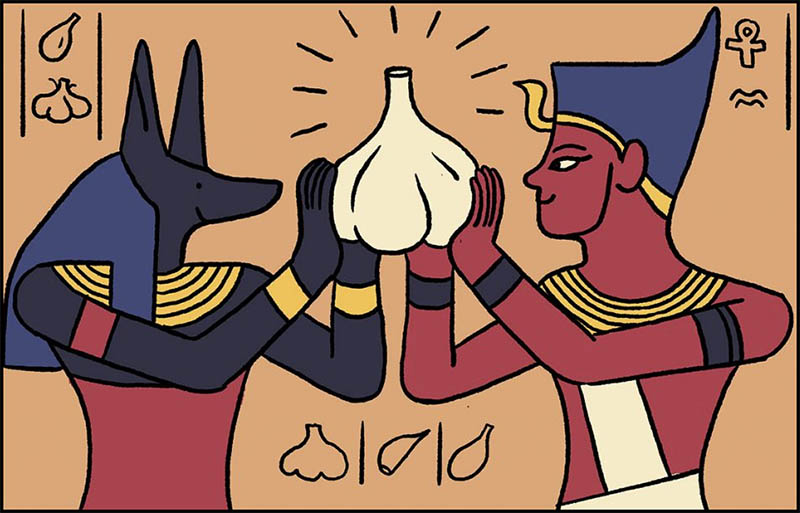History of garlic
Garlic has been part of our diet for thousands of years. It is believed that garlic was first cultivated by Sumerians on the shores of the Mediterranean over 5,000 years ago. Other sources claim that it came from the eastern plains of the Caspian sea, from where it later spread to Asia. The most probable explanation is that garlic came from the plains of Kazakhstan and Uzbekistan, and spread from there to China, and later on to countries in the Mediterranean.
In Egypt, under the reign of the pharaohs, garlic was known for its nutritional properties. Herodotus, the Greek historian, claimed that the workers who built the pyramids received a daily ration of garlic to give them the strength they needed to accomplish their exhausting task. Garlic was in fact a sacred plant in those days. Cheops even had effigies of garlic engraved inside his tomb! Garlic was also used for mummification and as a remedy for snake bites, and even accompanied the dead on their last trip to the world beyond.
The Greeks also believed in the healing properties of garlic. During the Olympic games, athletes would eat a clove of garlic to boost their physical performance.
According to Virgil, garlic was used by Roman farmers as a food for strength. These farmers introduced the plant to Italy, France, Spain and even England.
The Gauls also enjoyed garlic. Louis le Pieux, the son of Charlemagne, ordered that garlic be grown in the royal gardens. However, it wasn’t until the reign of Henry IV (1553-1610) that garlic became a truly popular plant. When the royal baby was born, its grandfather rubbed its lips with a clove of garlic to protect it against the evil eye, and give the future king the power to lead the nation, thereby perpetuating an ancient tradition of the Bearn!

In Mediterranean countries, people would hang up garlic and garlic braids to protect their homes. Harvested at the end of June, garlic was one of the traditional Midsummer Night herbs.
To this day many traditional festivals go on celebrating garlic. During these celebrations, garlic is braided in all sorts of fancy shapes.
Medicinal and dietetic properties of garlic
As early as 850 years B.C., Homer claimed that garlic had medicinal properties. Hippocrates, Aristophanes and Aristotle also praised the health benefits of garlic, the symbol of physical strength. The truth is that garlic is a genuine medicinal food which combines therapeutic and nutritional properties.
Garlic has been considered a universal remedy ever since Antiquity. In fact, garlic offers a wide range of medicinal properties which have been scientifically verified: antiseptic, bactericidal, depurative, diuretic, worming, anticancer, antipyretic, aphrodisiac, hypotensive, etc.
When fresh garlic is peeled and crushed it releases allicin which has antibiotic properties, and ajoene which has anticoagulant properties. This is why garlic was used as a prophylactic treatment for many infectious diseases: dysentery, typhoid fever, cholera, plague, diphtheria…
During the great plague of Marseille in 1762, four thieves – which had been arrested for looting – were granted pardon in exchange for revealing the secret of their immunity to the disease: a potion made with garlic, which became known as the ‘Vinaigre des 4 voleurs’ !
Garlic helps fight hypertension by dilating small capillaries. It also has anthelmintic properties, and gets rid of intestinal parasites. Finally, allicin inhibits tumours, hence its alleged anti-cancerous properties.

Four simple remedies
Mix 30 cl of apple cider vinegar with a tablespoon of Carum Carvi (a herb) and a tablespoon of fennel seeds. Bring to a boil, add 50g chopped raw garlic and leave to cook on a low flame for 5 minutes.
Filter and mix with 250g of honey. Bring to a boil and leave to cook on a high flame for 5 minutes. Leave to go cool and pour into a bottle or flask.
For a sore throat and coughing: adult, 1 tablespoon every two hours. Children, 1 teaspoon every two hours.
Cut a garlic clove in half and rub onto the bite/sting.
Introduce 25 cl of good quality oil (olive or wheat germ) into a bottle and add 4 crushed garlic cloves.
Seal the bottle and store for a week in a warm place.
Filter and rub the lotion once a day onto the painful area.
Crush a garlic clove and inhale several times a day.
Please consult the following sites: Passeport Santé and Phytomania for more information on the therapeutic and health benefits of garlic…
